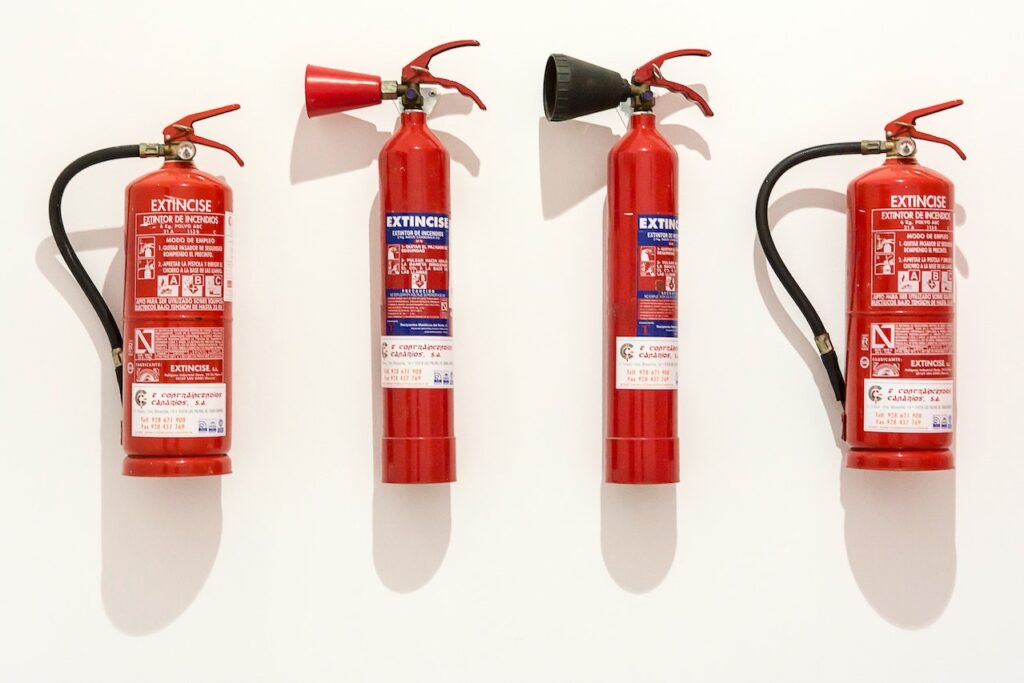Different types of Fire Extinguishers and How to Use them?

Fire safety is a critical aspect of protecting lives and property. One essential tool for fire safety is the fire extinguisher. Fire extinguishers are devices that are designed to extinguish or control small fires. They come in various types, each suitable for different types of fires. In this article, we will explore the different types of fire extinguishers and learn how to use them effectively.
Types of Fire Extinguishers
Dry Chemical Fire Extinguishers:
Dry chemical fire extinguishers are versatile and can be used on a wide range of fires, including those involving solid combustibles, flammable liquids, and electrical fires. They work by interrupting the chemical reaction of the fire, thereby extinguishing it. Dry chemical fire extinguishers are suitable for use in multi-risk environments such as kitchens and workshops.
Carbon Dioxide (CO2) Fire Extinguishers:
Carbon dioxide fire extinguishers are effective on fires involving flammable liquids and electrical fires. They work by displacing the oxygen from the fire, suffocating it, and extinguishing the flames. Carbon dioxide fire extinguishers are ideal for use in areas with electrical equipment, such as offices, server rooms, and laboratories, as they do not leave any residue and do not damage electrical equipment.
Wet Chemical Fire Extinguishers:
Wet chemical fire extinguishers are useful for tackling fires caused by cooking oils and fats, which are commonly found in commercial kitchens and restaurants. They work by cooling the fire and creating a soapy layer that prevents re-ignition. Wet chemical fire extinguishers are also effective on solid combustibles and flammable liquids.
Water-Fire Extinguishers:
Water fire extinguishers are the most basic type of fire extinguisher and are suitable for fires involving solid combustible materials such as wood, paper, and textiles. They work by cooling the fire and reducing the temperature below the ignition point, thereby extinguishing the flames. It is important to avoid using water fire extinguishers on fires involving flammable liquids or electrical equipment due to the risk of electrocution, as water conducts electricity.
Foam Fire Extinguishers:
Foam fire extinguishers are effective on fires involving flammable liquids such as gasoline, oil, and paint. The foam forms a barrier between the fire and the air, preventing the fire from spreading and extinguishing it. Foam fire extinguishers are also safe to use on solid combustible materials. However, like water fire extinguishers, they should not be used on electrical fires.
How to Use a Fire Extinguisher
Using a fire extinguisher can be a simple and effective way to control a small fire before it becomes uncontrollable. Here are the general steps on how to use a fire extinguisher effectively:
Assess the Situation:
Before attempting to use a fire extinguisher call 911 and report the fire then assess the situation and determine if it is safe to use the fire extinguisher. If the fire is spreading rapidly, is too large to handle with a fire extinguisher, or if there is dense smoke or toxic fumes, evacuate the area immediately and call the fire department.
Select the Appropriate Fire Extinguisher:
Choose the right type of fire extinguisher based on the type of fire you are dealing with. Refer to the fire inspection guidelines and ensure that the fire extinguisher is suitable for the specific type of fire.
Remember the PASS Technique:
The PASS technique is an acronym that stands for Pull, Aim, Squeeze, and Sweep, and it is a simple way to remember how to use a fire extinguisher effectively.
- Pull the pin to break the tamper seal and unlock the operating lever.
- Aim the nozzle at the base of the fire.
- Squeeze the lever to discharge the extinguishing agent, and maintain a steady grip on the extinguisher while doing so.
- Sweep the nozzle from side to side, covering the base of the fire with the extinguishing agent, until the flames are completely extinguished.
Be Mindful of Fire Hazards:
When using a fire extinguisher, be mindful of other fire hazards in the area. Avoid blocking escape routes, and do not turn your back to the fire. If the fire becomes uncontrollable or starts to spread, evacuate the area immediately and call for professional help.
Follow-Up with Fire Inspection:
After using a fire extinguisher, it is important to have the fire inspection conducted to ensure that the extinguisher is still in working condition and to identify any potential fire hazards that may have caused the fire. Proper maintenance and regular fire inspections of fire extinguishers are crucial to keep them in optimal working condition and ready for use in case of a fire emergency.
FireMaster provides a comprehensive selection of both portable and wheeled fire extinguishers, catering to diverse fire safety requirements. Our services include testing, maintenance, recharge, and repair of portable fire extinguishers, carried out by our skilled technicians who adhere to industry standards. With local offices and warehouses stocked with commonly used extinguishers, parts, signs, and safety items, our service vehicles are also equipped with a large inventory of replacement parts for convenient one-stop service. Trust us to provide superior fire extinguisher solutions and reliable maintenance to ensure they function when needed.
